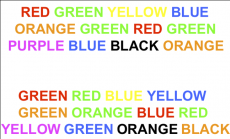
The Stroop effect is a psychological phenomenon in which it takes longer to name a colour if the colour is printed in an ink different from that colour. That was quite a mouthful, so here’s an example. Try reading the words to the right out loud, saying the name of the colour regardless of the colour of the ink.
If you did this test on a larger scale and timed yourself, you would find that the second set of words takes you longer to read, and you’ll be more prone to errors too. The effect is named after John Ridley Stroop, an American psychologist who published the effect in 1935 in the Journal of Experimental Psychology. His paper was called ‘Studies of Interference in Serial Verbal Reactions,’ and involved three variations on the same test, using three different stimuli (this means something that causes a response in the human body.)
1) Names of the colours in black ink
2) Names of the colours in different ink than the colour named
3) Squares of the colours
He found that participants took an average of 2.3 seconds longer to read 100 colour names if they were printed in colours different from that named by the word, than it took to read the same names all printed in black ink.

There are various explanations for this effect. The main theory involves the ‘interference’ mentioned in Stroop’s original paper title. Interference is an effect in human memory which occurs when learning new information. The interaction between the conflicting material, for instance the colour ink and colour names, causes a processing delay in the brain. This theory has led to the Stroop effect’s use in the diagnosis of certain psychiatric and neurological disorders which psychologists know causes increased interference in the brain, for example brain damage, dementia, attention-deficit hyperactivity disorder, and schizophrenia.
Another theory relates to the brain’s processing speed of different stimuli. This states that it takes the brain longer to recognise colours than it does to recognise words, partly because the brain automatically understands word meanings due to habitual reading. An easy way to test this would be to conduct the Stroop test on young children who have less reading experience. A related selective attention theory argues that it takes the brain more attention to recognise colour than to reads words. For this reason the Stroop test has also been used to measure people’s selective attention capacities, helping to assess the effect of texting while driving for instance.
There are a few variations on the standard Stroop test. One is the emotional Stroop test, in which negative emotional words, like ‘grief,’ ‘violence,’ and ‘pain,’ are mixed with more neutral words, like ‘book,’ ‘door,’ and ‘toaster’. These words are printed in various colours, and again the participant is asked to name to colour, not the word. Tests found that individuals suffering from depression were more likely to say the colour of a negative word slower than the colour of a neutral word. This test demonstrates the conflict provided by the emotional relevance of the word to the individual.
Images: http://jesusgilhernandez.com/wp-content/uploads/2014/04/stroop.png
http://i.huffpost.com/gen/1295043/images/o-TEXTING-DRIVING-facebook.jpg

0 Comment:
Be the first one to comment on this article.